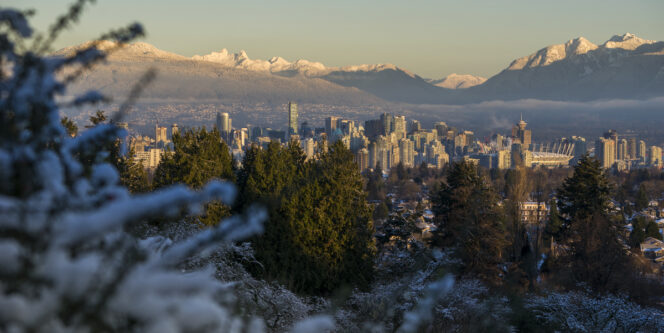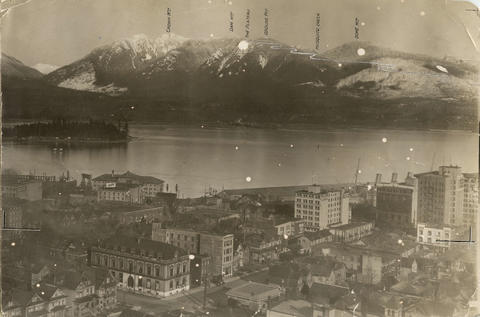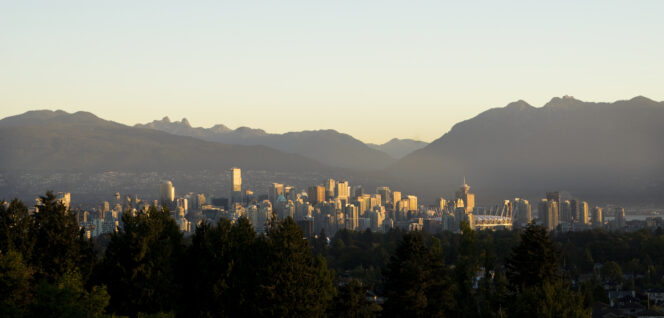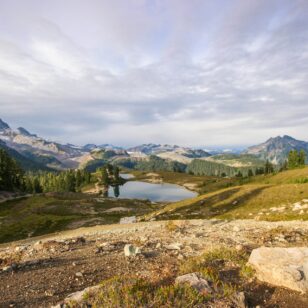
The North Shore Mountains from Queen Elizabeth Park in Vancouver. Photo: Destination BC/Jordan Manley
Vancouver’s North Shore Mountains provide a stunning backdrop for our city. You may know the names of some of the peaks, but do you know the stories behind them? Here’s a brief look into the history of the names of the local mountains.
Mount Seymour
Consisting of three distinct peaks, Mount Seymour is named after Frederick Seymour, who was governor of the colony of British Columbia between 1864 and 1869. The first, and lowest peak is often called Pump Peak since one of the first men to climb it thought that a weathered tree near the summit looked like a water pump. The middle peak was officially named Tim Jones Peak in 2017 after the former head of North Shore rescue who passed away after suffering a heart attack lower down on the mountain in 2014. You can hike to all three peaks using our Mount Seymour hiking guide.
The indigenous Coast Salish people knew the entire Mount Seymour watershed as Ch’ich eliwxih. The name may come from the Squamish word ch’ich, which means “pure land” since the mountains were an important area for spiritual practice.
Lynn Peak
The forested ridge of Lynn Peak takes its name from nearby Lynn Creek, which in turn is named after John Linn, a British Royal Engineer who was one of North Vancouver’s early settlers in the 1860s. It is thought that a clerical error in the early 1900s resulted in “Linn” being recorded as “Lynn”.
Grouse Mountain
After a group of hikers shot a blue grouse on a trip in 1894, they decided to name the mountain after the bird. The blue grouse is a chicken-sized and lives in forested mountain habitats all over North America. If you’ve ever heard a low “whump-whump-whump” noise while hiking, you were listening to a male blue grouse trying to attract a mate or defend their territory. Today you can reach the summit of Grouse Mountain via the Skyride and then the Peak Chairlift.

View of the North Shore Mountains from Vancouver circa 1925. The peaks are hand-labelled Crown Mountain, Dam Mountain, Grouse Mountain, and Dome Mountain. Photo: Stirrett, G.P./Grouse Mountain Highway and Scenic Resort
Mount Fromme
Tucked into the eastern shoulder of Grouse Mountain, forested Mount Fromme doesn’t get as much publicity as its neighbour. The peak is named for Julius Fromme, one of the first loggers in North Vancouver’s Lynn Valley in the 1880s. He later served as mayor of North Vancouver. In the 1920s it was sometimes known as “Dome Mountain” since it was so heavily logged. Today the lower slopes of Mount Fromme are one of Vancouver’s best mountain biking destinations.
Crown Mountain
Nestled behind Grouse Mountain, Crown Mountain is best viewed from Spanish Banks. From there, you can see the dramatic circle of craggy spires that gave the peak its name – it looks like a crown. In 1860 Captain Richards of the Royal Navy added the name “Crown Mountain” to one of the first charts of the Vancouver area. One of the rocky sub-summits of Crown Mountain is nicknamed The Camel since it resembles the profile of its namesake desert animal.
The Lions
In the 1880s, BC Supreme Court Justice John Hamilton Gray gave the lions their name as he thought they looked like pair of big cats laying down. In the Squamish language, the Lions are known as Ch’ich’iyúy, which means twins. In a Squamish story, two of the chief’s daughters help broker peace between the Squamish and another tribe, so the Great Spirit made them immortal by turning them into mountains so they could be a symbol of peace forever.

Black Mountain, the Lions, and Grouse Mountain behind Vancouver’s skyline. Photo: Destination BC/Jordan Manley
Cypress Mountain
You might be surprised to discover that there is no summit called Cypress Mountain on Vancouver’s North Shore. The ski resort with that name used to be called Cypress Bowl, since it sits across three mountains (Hollyburn Mountain, Mount Strachan, and Black Mountain) that are drained by Cypress Creek. The creek gets its name from the yellow cedar tree, a member of the cypress family which grows high on mountains in wet, coastal climates from California to Alaska.
Hollyburn Mountain is named after a group of holly bushes growing far down the mountain in the Ambleside area. In the 1850s a forest fire charred the slopes of Black Mountain, giving rise to its name. Pronounced “strawn”, Mount Strachan is named after Admiral Sir Richard John Strachan of the British Navy. (Use our Mount Strachan trail guide to hike to the summit.)
















